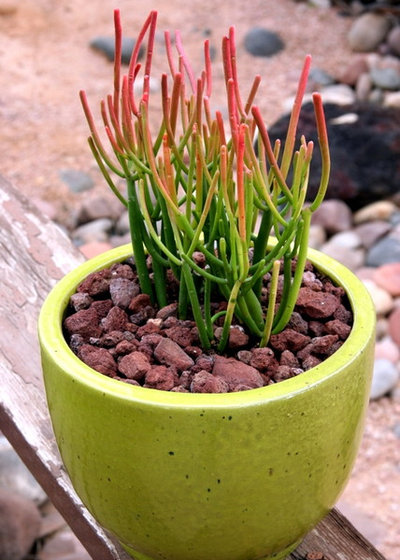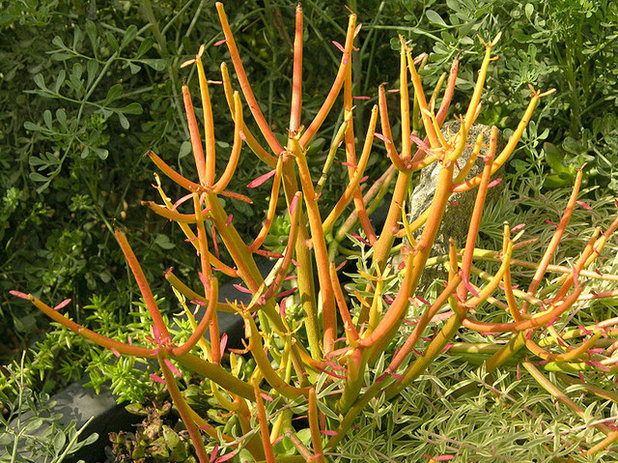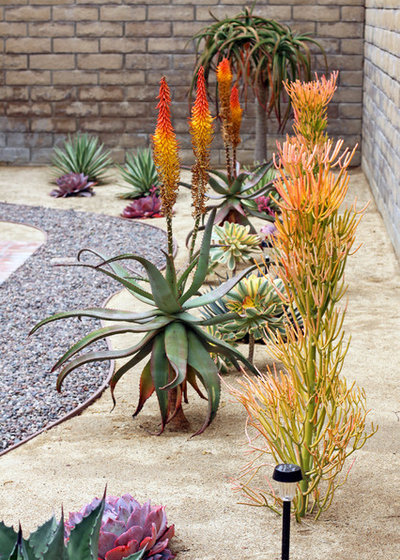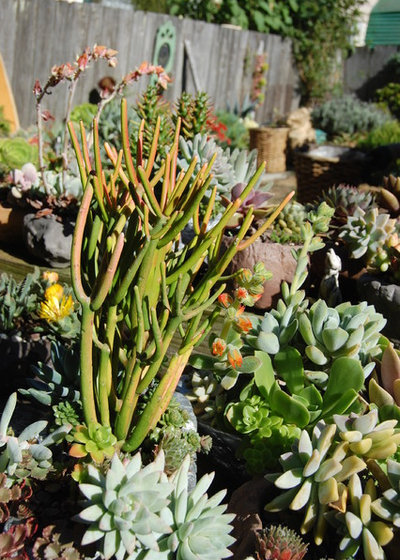Succulents are architectural and clean-textured garden accents, adding modern funk and humor to your planting palette. Milk bush
(Euphorbia tirucalli), also known as pencil tree, takes that description to the extreme. With its open structure and rubbery, cartoon-like branches, it's eye-catching and exotic — even in the realm of succulents.
Caution: Be sure to avoid direct skin contact, as this plant's milky sap is toxic.

Tracy27
Botanical name: Euphorbia tirucalliCommon names: Milk bush, pencilbush, pencil tree, Indian tree spurge
USDA zones: 10 to 11 (find your zone)
Water requirement: Minimal; drought tolerant
Sun requirement: Full sun
Mature size: Can reach up to 30 feet tall (more likely to be kept small)
Benefits and tolerances: Drought and coastal tolerant; flowers attract bees and birds; used by birds for nesting
Seasonal interest: Evergreen; flowers are insignificant
When to plant: Propagate by cuttings. Caution: When pruning, planting or transporting milk bush, wear gloves and long sleeves, and even consider goggles to avoid direct contact with the toxic white sap. After pruning the plant or trimming cuttings, allow the stems to dry out or seal them to contain the sap.
 Distinguishing traits.
Distinguishing traits. The most apparent and obvious features of this succulent shrub are its habit and color. Whereas other succulents form tighter rosettes, milk bush branches and spreads. Imagine the shadow it casts.
Milk bush is a freely branching, upright tree or shrub. While in its native African environment it reaches sizes of up to 30 feet tall, it tends to be much smaller in domestic cultivation.
Sticks on Fire, shown here, is a popular milk bush cultivar. Colorful foliage turns bright yellow in summer and returns to a vibrant red in winter. Because these cultivars lack the amount of chlorophyll of the straight species, they are also slower growing.
Photo by Wikimedia Commons user Derek Ramsey

Flea Market Sunday
How to use it. Treat milk bush as an architectural accent in the garden — the form contrasts other rosette-shape succulents and the rubbery texture adds foliage structure. Milk bush adds visual diversity in an all-succulent garden and textural and structural shape to mixed foliage beds.
See more of this exotic garden and home

Glenna Partridge Garden Design
Planting notes. Plant it directly in the ground, in containers or even indoors, if conditions are warm and dry.

Far Out Flora
Plant it in well-drained soil that will remain mostly dry. It’s very tolerant of salt and wind and will grow right along the coast. It’s not very hardy — only to about 30 degrees Fahrenheit — but you can always bring it indoors if your winters are cold.





